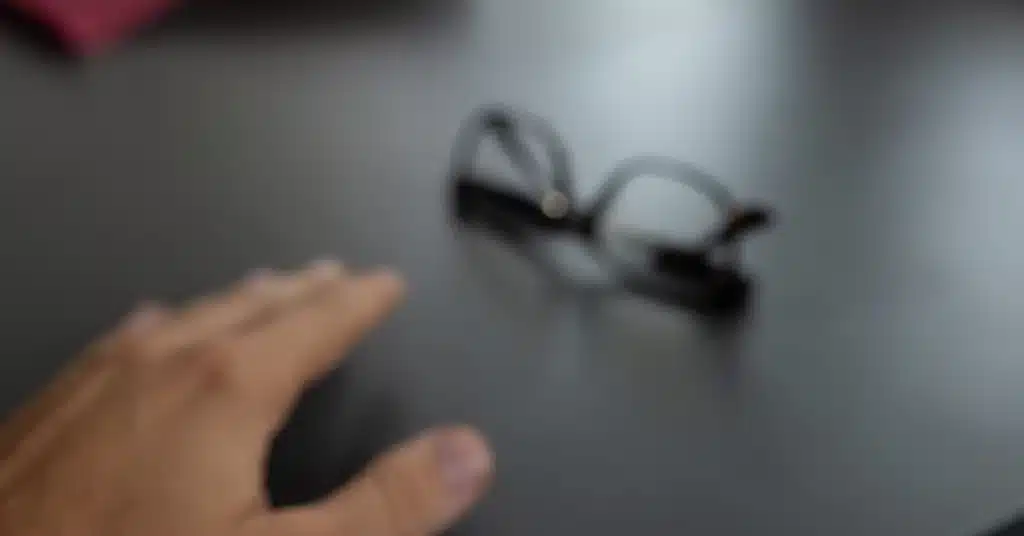Glaucoma is a group of eye conditions that can cause damage to the optic nerve. It occurs as a result of increased pressure in the eye due to fluid buildup.
It has the potential to cause vision loss and blindness over time. The symptoms of this condition may manifest gradually, so they may not be immediately noticeable.
However, as the condition progresses, vision changes may become apparent. So, what does vision look like with Glaucoma?
This article discusses the visual changes associated with Glaucoma to increase awareness for early detection and proper management.
What does vision look like with Glaucoma
Glaucoma may cause various visual concerns, such as blurry vision, narrowed field of vision, the appearance of halos, and blind spots.
The symptoms of Glaucoma are typically not very noticeable initially. However, if this condition is left untreated, it can worsen over time.
It typically starts with decreased peripheral vision, progressing to blurred vision, and eventually to complete vision loss.
Understanding the visual changes associated with Glaucoma is important for early detection and effective management.
Let us discuss the effects of early Glaucoma vision in detail:
- Blurry vision: It is an early sign of Glaucoma. Objects may appear hazy or out of focus, especially in the peripheral vision. Blurriness can worsen over time.
- Tunnel vision: Glaucoma can lead to tunnel vision. The field of vision narrows, resembling a tunnel view. Peripheral vision is restricted, making seeing objects or people on the sides hard.
- Halos: Glaucoma can cause halos (bright rings or circles) around light sources, especially at night. They are caused by light scattering within the eye due to increased IOP.
- Blind spots: Glaucoma damages the optic nerve, causing blind spots in the visual field. These areas may enlarge and become more noticeable over time due to lacking detail and clarity.
- Difficulty adapting to low light conditions: Glaucoma can affect light perception. Some people may become more sensitive to bright light, causing discomfort or glare.
Others may need help in low-light environments and struggle to distinguish objects clearly.
Want to know about the blindness caused by Glaucoma? Read our article: Does Glaucoma Cause Blindness? Understanding the Risk and Prevention
How do different types of Glaucoma affect vision
The symptoms of Glaucoma can differ based on the type of the condition. The different types of Glaucoma can have varying degrees of impact on vision.
The different types of Glaucoma are Open-angle, Angle-closure, Normal-tension, and Congenital Glaucoma.
Open-angle Glaucoma is usually asymptomatic initially and progresses gradually, while Angle-closure has a rapid onset.
Normal-tension Glaucoma involves normal eye pressure but leads to progressive visual field loss. Congenital Glaucoma has been present since birth.
Let us discuss what vision looks like with different types of Glaucoma.
Open-Angle Glaucoma
Open-angle Glaucoma is often asymptomatic in the early stages, but a gradual decrease in peripheral vision is common.
It causes tunnel vision in the advanced stages, but central vision remains until late.
The progression of this type is slow and can only be noticed once significant visual field loss occurs.
Angle-Closure Glaucoma
 Source: zoranm_from_Getty_Images
Source: zoranm_from_Getty_ImagesAngle-Closure Glaucoma occurs in sudden severe eye pain, blurred vision, and halos around lights.
It has a rapid onset and causes severe visual disturbances. This Glaucoma type is severe and requires immediate medical attention.
Normal-Tension Glaucoma
The intraocular pressure (IOP) remains within the normal range in Normal-tension Glaucoma.
The symptoms include progressive visual field loss despite normal pressure. It is typically only possible with comprehensive evaluation beyond pressure measurements.
Congenital Glaucoma
Congenital Glaucoma is present from birth. It leads to enlarged eyes, light sensitivity, and excessive tearing.
Early intervention is crucial to prevent loss in infants.
The following table covers the symptoms of different types of Glaucoma in the early and advanced stages:
| Category | Open-angle Glaucoma | Angle-closure Glaucoma | Normal tension Glaucoma | Congenital Glaucoma |
|---|---|---|---|---|
| Onset | Typically in adulthood | Can occur suddenly | Typically in adulthood | Present from birth |
| Early stages | Often asymptomatic, peripheral vision loss possible | Sudden onset of severe eye pain, blurred vision, halos around light | Intraocular pressure within normal range | Enlarged eyes, light sensitivity, excessive tearing |
| Advanced stages | Tunnel vision (central vision may remain), blurred vision, halos around lights | Severe eye pain, blurred vision, halos around lights | Progressive visual field loss despite normal pressure | Cloudiness of the cornea, sensitivity to light |
Glaucoma vision — takeaway
If you have a family history of Glaucoma or noticed changes in your eyesight, you might want to know, “What does vision look like with Glaucoma?”.
Understanding how Glaucoma impacts vision is critical for early detection and intervention.
Regular eye examinations are essential, especially for individuals at higher risk. It can help you get treatment on time and preserve your vision.
If you or a loved one notices these visual changes, seek immediate professional care.
Early detection and management are crucial in minimizing the impact of Glaucoma on vision and overall quality of life.
Frequently Asked Questions
What does Glaucoma do to your vision?
Glaucoma can cause various changes in your vision, including blurry vision, tunnel vision, halos around lights, blind spots, and difficulty adapting to light conditions.
How long does it take for Glaucoma to affect vision?
The progression of Glaucoma can vary. In certain situations, there can be observable vision changes over time, while in other cases, it may develop gradually or show no symptoms for long periods. Timely detection and treatment are important in managing the condition.
Is Glaucoma hereditary?
Glaucoma can occur due to genetic factors. Regular eye check-ups are essential if you have a family history of Glaucoma.
Can Glaucoma-related vision loss be reversed?
No, vision loss from Glaucoma is irreversible. Early detection and treatment aim to prevent further damage.
Can Glaucoma lead to complete blindness?
While untreated Glaucoma can result in noticeable vision loss, complete blindness is not commonly observed. Timely intervention is important.
When referencing outside resources, GoodrxMedicine always provides full citations. To learn more about the measures we use to maintain the quality of our content, please review our Content Information Policy.











